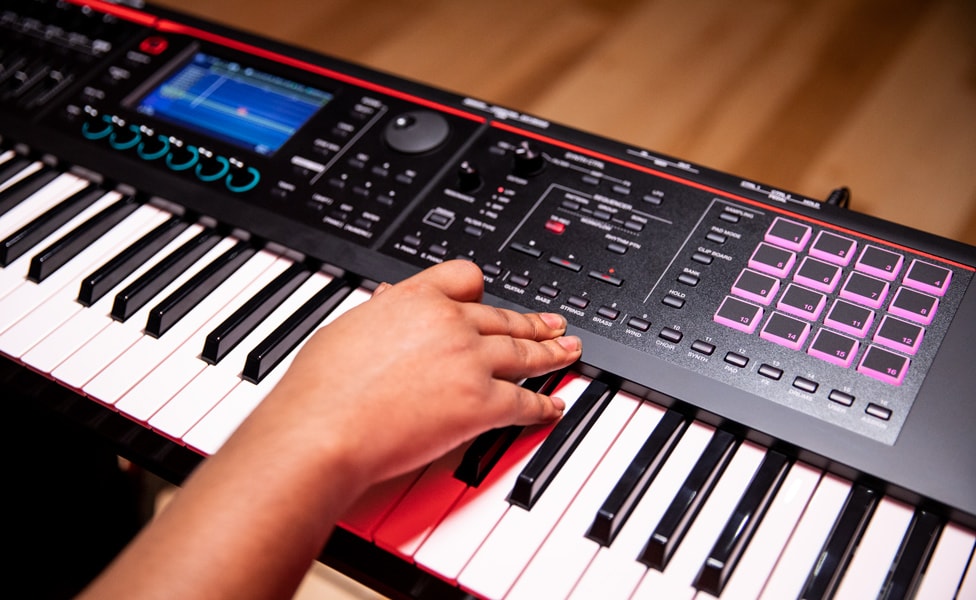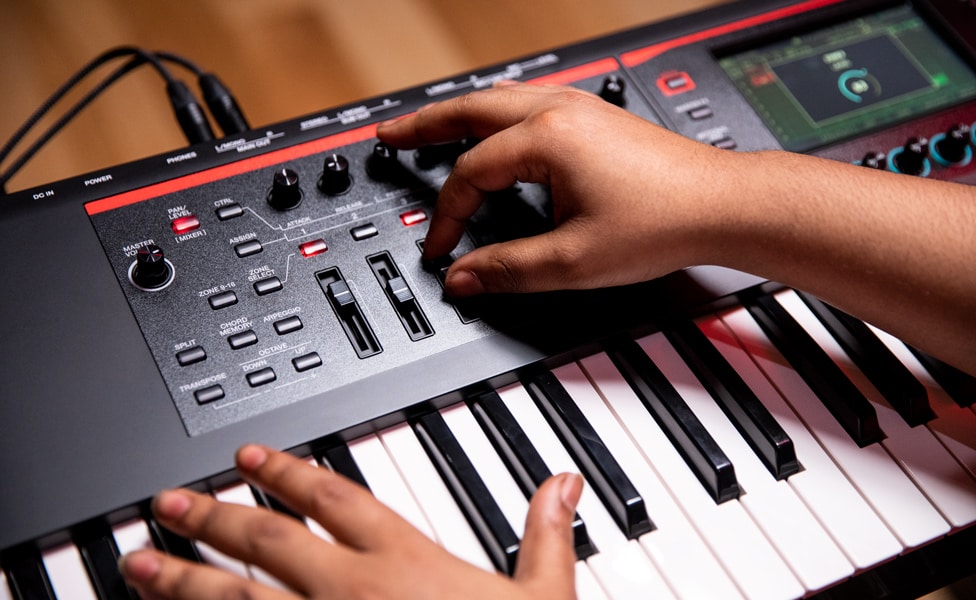Drawing upon the legacy of the feature-rich FANTOM synthesizers, Roland has thoughtfully created the new FANTOM-0 series. Designed to streamline creative and live performance workflows alike, it bypasses common technical hurdles by virtue of its seamless DAW integration with Logic Pro, MainStage and Ableton Live, intuitive interface and easy organization of tones, effects, levels and sequences in “Scenes.” With its ZEN-Core synthesis system and an ever-growing Roland Cloud library, it packs an expansive sonic palette fit for any studio or live setup.
We spoke with Duane McDonald, project manager of synth and tech at Roland Americas, for an insider’s perspective on the FANTOM-0 series. To see it in action, enjoy the FANTOM-07 video demonstration by Chopsquad DJ.
The FANTOM lineage has a respected provenance as a synthesizer, workstation and production tool. For those new to the line, can you describe its basic concept and share how the FANTOM-0 has evolved to meet today’s creative moment?
Duane McDonald: The FANTOM series is built to inspire creativity and reduce the technical barriers that tend to interfere with the creative process. It features a modeless user interface that allows users to jump right in and start creating without the hassle of setting up a project. We also understand that most of musicians will be using the FANTOM with DAW software at some stage, and we designed it to make that process as easy as possible.
The FANTOM-0's "Scenes" are an agnostic way of looking at organized sound. Tell us about how this concept of custom creative spaces works. What are some standard uses, as well as some deeper, extended uses musicians should be aware of?
Scenes are used to organize everything from tones, effects, levels and sequence patterns. They are commonly used to create layered or split sounds, or to hold patterns for a song. In a production environment, they might be used to create multiple patterns that each contain different potential sections of a song. The FANTOM-0’s clip-based sequencer lets you experiment with different arrangements of your song by simply choosing different groups of patterns to play back. A deeper use of scenes in a live setting is to select up to 16 different instruments that you want to use in a song, or entire set, and use the keyboard switch group function to turn those sounds on and off without leaving the scene. You can even use the pads to select different groups of sounds.

One of its most powerful features is the FANTOM-0's ability to interface with the studio. Tell us more about how native DAW integration works, what it supports and some tips for adding it to an existing production setup.
The FANTOM-0 can be used with any DAW simply by connecting a USB cable. It features a built-in 4-in/32-out interface, and the knobs and sliders on the FANTOM-0 can transmit MIDI messages to control functions of your DAW. For certain DAWs, such as Apple Logic Pro and Ableton Live, we offer a DAW control mode that maps out most of the common controls, and even displays important aspects of your DAW project on the FANTOM-0 display—letting you interact with your DAW without having to switch between your mouse and the FANTOM hardware controls.
The deep sampling functionality supports a variety of capture and triggering methods. Can you elaborate on a few ways a user could import, capture and play their own sounds?
Samples can be added to the pads for triggering or directly to the keyboard, so they can be played back at different pitches using the FANTOM-0 keyboard. When using the pads to play back samples, there are several options, including a loop-based method that is great for playing along with a finished sample loop that you can turn on and off by simply hitting the pad. For the more adventurous, FANTOM-0 lets you build detailed multisamples that can be used as a new ZEN-Core tone.
In addition to sampling, there are many ways to build and craft your own sounds within the FANTOM-0 environment. Can you walk us through some of those techniques?
The FANTOM-0 comes with thousands of sounds to cover a multitude of musical styles and genres. To make it easier to navigate those sounds, there is a built-in review system called Favorites. When you are auditioning sounds, you can designate them as a favorite and rate them as one-star, two-stars or three-stars. This helps you narrow your choices when you are looking to create a new sound. You can filter by sound category and display only three-star synth pads for example. Another tip for creating your own sounds is to use the extensive LFO options to add motion to your sound. The FANTOM-0 features a step LFO option that can be used to create complex, evolving sounds that synchronize with the tempo of your song.
Roland has a vast ecosystem of sounds, voices and expansions. Can you describe how the FANTOM-0 works within this ecosystem and what its users have access to?
In addition to the onboard sound library, you can expand and customize the sounds in your FANTOM-0 through Roland Cloud. Roland Cloud contains thousands of additional sounds, sample packs and wave expansions that users can add to the FANTOM-0. They can even add complete synth engines with sounds and new graphical user interfaces that can be purchased and loaded into the FANTOM-0. These include legendary Roland synths, such as the JUPITER-8, JUNO-106, JX-8P and SH-101.

What traces of classic Roland gear are evident in the FANTOM-0?
Users familiar with the Roland RD-2000 Stage Piano will be very comfortable navigating the zones with the slider layout on the FANTOM-0 series. That interface was so well designed for live and studio use that it inspired the FANTOM design. The Virtual ToneWheel Organ sound engine is essentially the latest in our popular VK series of organs. When you use the VTW engine, we have included a graphic user interface that displays the drawbars and other important elements of a physical organ, and makes clever use of the FANTOM-0 hardware controls, such as inverting the sliders to function as drawbar controls and using the pitch bend to change the rotary speed. Similar design choices were made for each of the legendary synths available as Model Expansions.
The FANTOM is a beloved stage instrument. What are some workflow and form-factor enhancements that make the FANTOM-0 even more concert-friendly?
The first thing that a gigging musician will notice about the FANTOM-0 series is the weight, or lack of it. While the flagship FANTOMs are built to withstand the rigors of a professional tour, the FANTOM-0 is built for customers that don’t have their own road crew. The FANTOM-06 weighs just 13 lb. Even the FANTOM-08 comes in at just over 32 lb., which is great for a high-quality, weighted-action keyboard. FANTOM-0 also features an additional set of outputs which are useful for routing click sounds to a drummer. For customers that use Apple MainStage, the FANTOM-0 lets you connect a single USB cable and route the audio from MainStage through the FANTOM-0 outputs and control your MainStage performance right from the FANTOM-0 touchscreen.

For musicians considering the FANTOM-0, what are a few of its greatest strengths within today’s music creation landscape?
The greatest strengths of the FANTOM-0 are the features that enable creativity. The modeless UI that lets you start the process as soon as inspiration hits, the vast collection of incredible sounds that can be inspiring on their own, and the modern clip-based sequencer that enables you to quickly capture those ideas. Combining those features in a portable and affordable package, the FANTOM-0 series is built to be the centerpiece of a studio or live keyboard rig.
Learn more about the Roland FANTOM-06, FANTOM-07 and FANTOM-08 synthesizer workstations.
Keep up with Chopsquad DJ.





